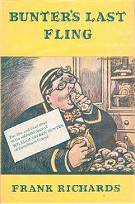
Bunter's Last Fling by Frank Richards.
Published September 1965 by Cassell & Co
Illustrated by C. H. Chapman.
The 38th & final
Bunter book in the Cassells series. It appeared in 1965, four years after
Hamilton’s death.
So, who wrote this? Certainly not the real Charles Hamilton. Some experts have suggested this was the work of his niece, Una Hamilton-Wright. The book is copyrighted to her.
The whole appearance of the prose is different to that of Frank Richards. There are far less white spaces; the style is compacted by comparison. Plot-wise, this is a neat little story. Events, which had occurred in the previous story, are referred to. As in the original Magnet, there is a sense of continuity here as though the author was writing a serial, not a separate novel.
Smithy’s cousin, Bertie, from the impoverished Vernon side of the family is introduced. There is a scheme afoot to usurp the Bounder in his father’s affections, so that Bertie may one day control the Vernon-Smith millions.
The story begins in a very unpleasant way. It disturbed this reader in 1965 as much then as it does now. Pon & Co. at Redclyffe station set upon Billy Bunter. No ordinary rag this, it is sadistic & malicious even by Ponsonby’s standards. Bunter is gagged, tied hand & foot, & nailed up in a wooden crate on the platform. He is then abandoned to be carried goodness knows where on the railway.
Whilst in this situation he overhears a plot between Bertie Vernon & his cousin, George.
Coker features heavily in this story. In his own Cokerish way, he comes across rather well. The writer obviously had a great deal of affection for this character. But, the rest of the ensemble come across as cardboard, & two-dimensional. At one stage, it is Bulstrode is mentioned as being a Removite! On another occasion, Bunter avoids his study, number 7, where he is hoping to devour tuck in secret. Toddy & Dutton are absent, but Mauly is chatting in there with Brown. Why?
Bunter comes out rather well in this story. Perhaps as a reward for being imprisoned in a crate, both Coker & Smithy give him a succession of free feeds. Very convincing!
Surprisingly, we read very little about Bertie Vernon. There are no interactions with his form fellows, for example.
In a genuine Hamilton story, a character’s personality & traits are defined, by & large, by the reactions of other people. Sometimes these are implied, on other occasions they are implicit. Unlike Edwy Searle Brooks, it is not the author who tells you that this or that person is a cad, it is the other characters. Here, the author is far more Brooksian than Hamilton.
There are no “hallo, hallo, hallo’s,” from Bob Cherry. None of the characters, apart from Coker, display any of the unique individuality and credibility we are used to.
It’s difficult to work out why this book was published, apart from the obvious desire to cash in on a popular market.
It is rather sad, that nearly twenty years previously, Bunter had entered the post-war book market so triumphantly, only for him to leave it so pathetically.
He deserved a better epitaph than this!